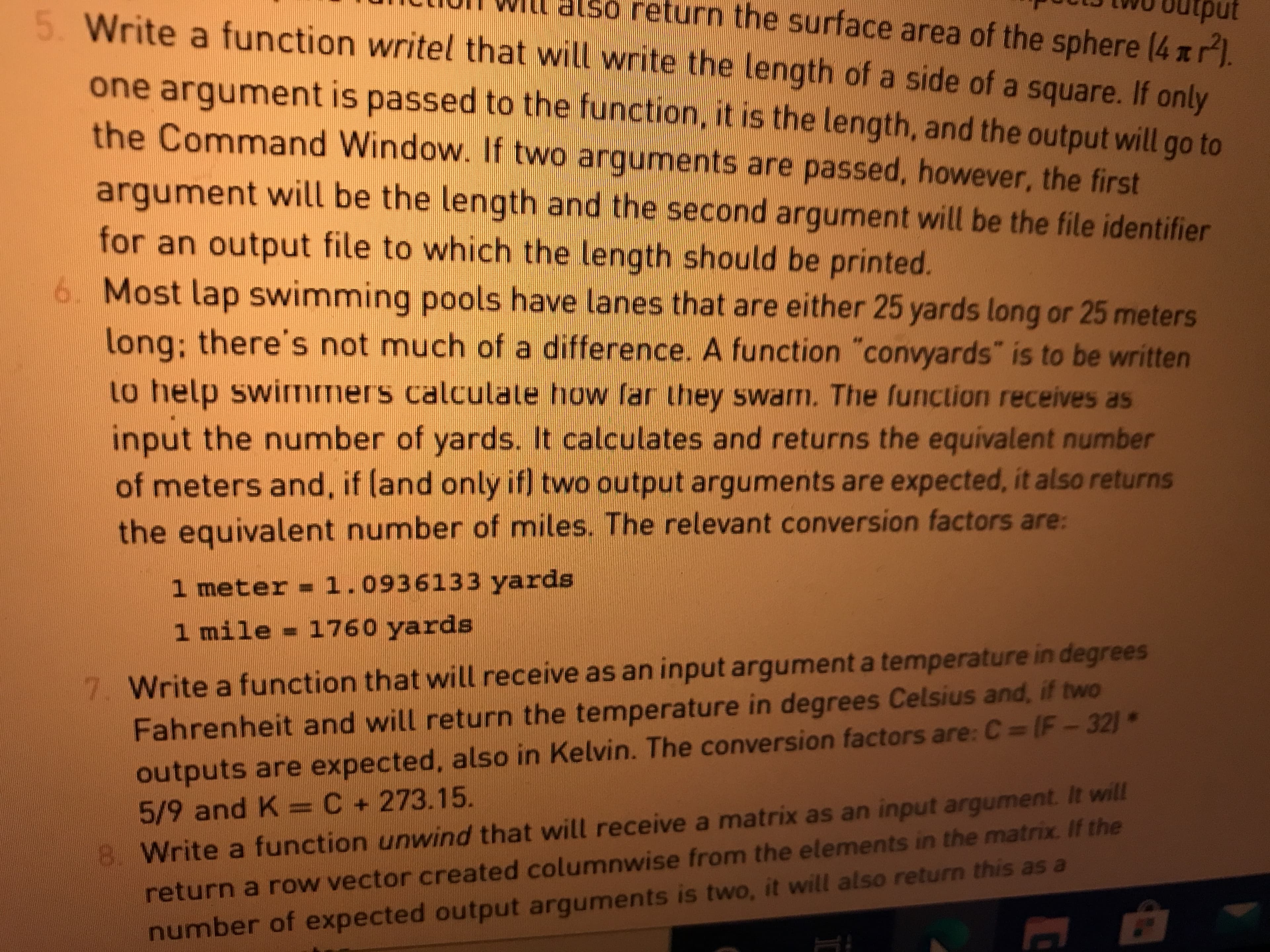return the surface area of the sphere (4 xr). put 5. Write a function writel that will write the length of a side of a square. If only one argument is passed to the function, it is the length, and the output will go to the Command Window. If two arguments are passed, however, the first argument will be the length and the second argument will be the file identifier for an output file to which the length should be printed. 6. Most lap swimming pools have lanes that are either 25 yards long or 25 meters long; there's not much of a difference. A function "convyards" is to be written lo help swimmers calculate how far they swarm. The function receives as input the number of yards. It calculates and returns the equivalent number of meters and, if (and only if) two output arguments are expected, it also returns the equivalent number of miles. The relevant conversion factors are: 1 meter = 1.0936133 yards 1 mile = 1760 yards 7. Write a function that will receive as an input argument a temperature in degrees outputs are expected, also in Kelvin. The conversion factors are: C (F-321 5/9 and K =C + 273.15. Fahrenheit and will return the temperature in degrees Celsius and, if two 8. Write a function unwind that will receive a matrix as an input argument. It will return a row vector created columnwise from the elements in the matrix. If the number of expected output arguments is two, it will also return this as a
return the surface area of the sphere (4 xr). put 5. Write a function writel that will write the length of a side of a square. If only one argument is passed to the function, it is the length, and the output will go to the Command Window. If two arguments are passed, however, the first argument will be the length and the second argument will be the file identifier for an output file to which the length should be printed. 6. Most lap swimming pools have lanes that are either 25 yards long or 25 meters long; there's not much of a difference. A function "convyards" is to be written lo help swimmers calculate how far they swarm. The function receives as input the number of yards. It calculates and returns the equivalent number of meters and, if (and only if) two output arguments are expected, it also returns the equivalent number of miles. The relevant conversion factors are: 1 meter = 1.0936133 yards 1 mile = 1760 yards 7. Write a function that will receive as an input argument a temperature in degrees outputs are expected, also in Kelvin. The conversion factors are: C (F-321 5/9 and K =C + 273.15. Fahrenheit and will return the temperature in degrees Celsius and, if two 8. Write a function unwind that will receive a matrix as an input argument. It will return a row vector created columnwise from the elements in the matrix. If the number of expected output arguments is two, it will also return this as a
Power System Analysis and Design (MindTap Course List)
6th Edition
ISBN:9781305632134
Author:J. Duncan Glover, Thomas Overbye, Mulukutla S. Sarma
Publisher:J. Duncan Glover, Thomas Overbye, Mulukutla S. Sarma
Chapter6: Power Flows
Section: Chapter Questions
Problem 6.22P
Related questions
Question
I need the soulution to chapter 10, #6
this is from Matlab a practical introduction to programming and problem solving 5th edition

Transcribed Image Text:return the surface area of the sphere (4 xr).
put
5. Write a function writel that will write the length of a side of a square. If only
one argument is passed to the function, it is the length, and the output will go to
the Command Window. If two arguments are passed, however, the first
argument will be the length and the second argument will be the file identifier
for an output file to which the length should be printed.
6. Most lap swimming pools have lanes that are either 25 yards long or 25 meters
long; there's not much of a difference. A function "convyards" is to be written
lo help swimmers calculate how far they swarm. The function receives as
input the number of yards. It calculates and returns the equivalent number
of meters and, if (and only if) two output arguments are expected, it also returns
the equivalent number of miles. The relevant conversion factors are:
1 meter = 1.0936133 yards
1 mile = 1760 yards
7. Write a function that will receive as an input argument a temperature in degrees
outputs are expected, also in Kelvin. The conversion factors are: C (F-321
5/9 and K =C + 273.15.
Fahrenheit and will return the temperature in degrees Celsius and, if two
8. Write a function unwind that will receive a matrix as an input argument. It will
return a row vector created columnwise from the elements in the matrix. If the
number of expected output arguments is two, it will also return this as a
Expert Solution
This question has been solved!
Explore an expertly crafted, step-by-step solution for a thorough understanding of key concepts.
This is a popular solution!
Trending now
This is a popular solution!
Step by step
Solved in 2 steps with 2 images

Knowledge Booster
Learn more about
Need a deep-dive on the concept behind this application? Look no further. Learn more about this topic, electrical-engineering and related others by exploring similar questions and additional content below.Recommended textbooks for you

Power System Analysis and Design (MindTap Course …
Electrical Engineering
ISBN:
9781305632134
Author:
J. Duncan Glover, Thomas Overbye, Mulukutla S. Sarma
Publisher:
Cengage Learning

Power System Analysis and Design (MindTap Course …
Electrical Engineering
ISBN:
9781305632134
Author:
J. Duncan Glover, Thomas Overbye, Mulukutla S. Sarma
Publisher:
Cengage Learning